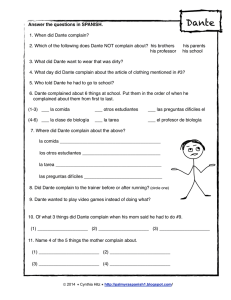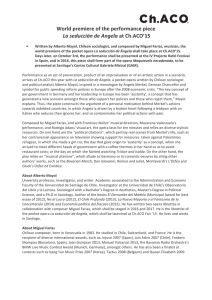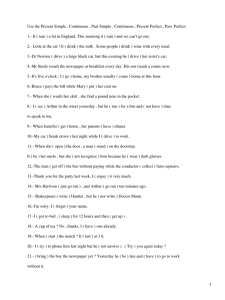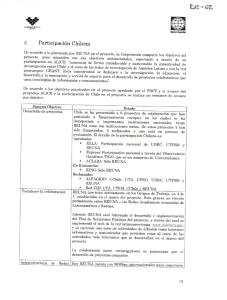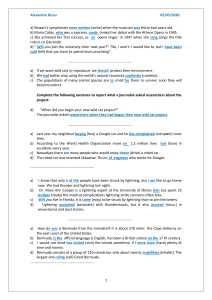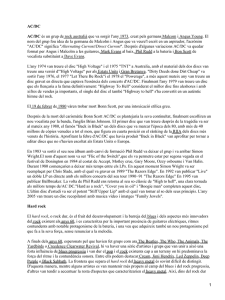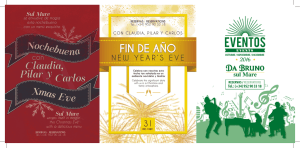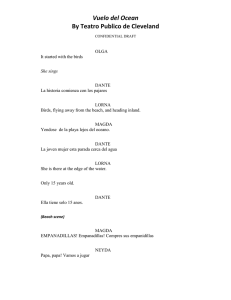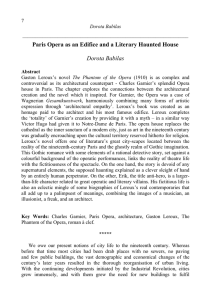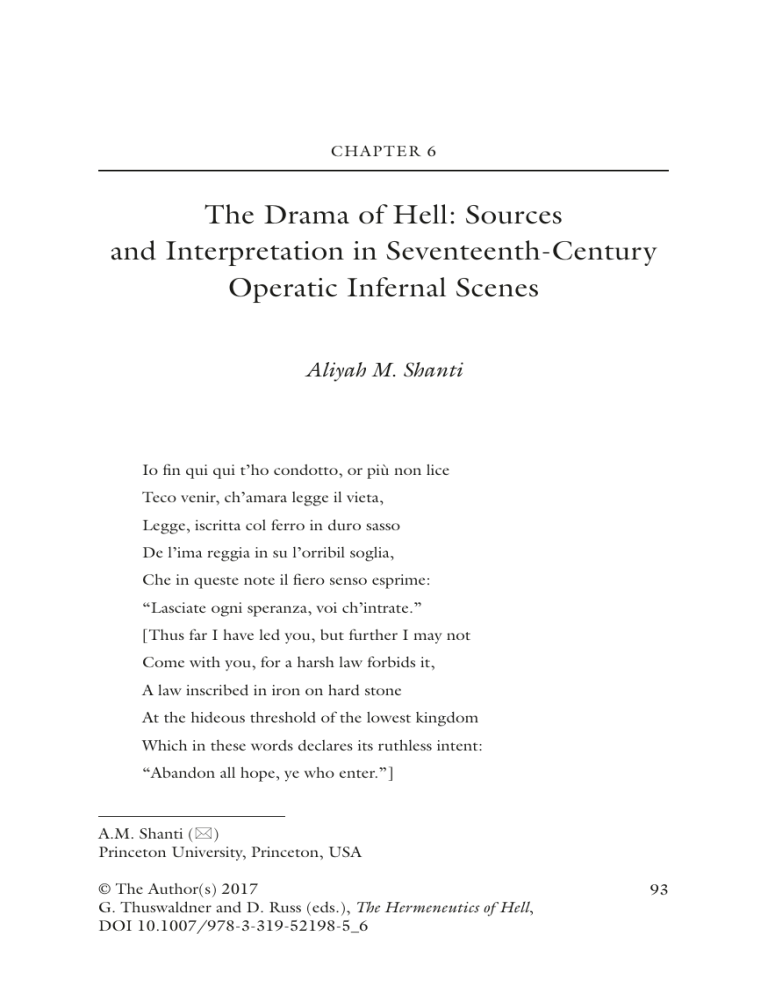
CHAPTER 6 The Drama of Hell: Sources and Interpretation in Seventeenth-Century Operatic Infernal Scenes Aliyah M. Shanti Io fin qui qui t’ho condotto, or più non lice Teco venir, ch’amara legge il vieta, Legge, iscritta col ferro in duro sasso De l’ima reggia in su l’orribil soglia, Che in queste note il fiero senso esprime: “Lasciate ogni speranza, voi ch’intrate.” [Thus far I have led you, but further I may not Come with you, for a harsh law forbids it, A law inscribed in iron on hard stone At the hideous threshold of the lowest kingdom Which in these words declares its ruthless intent: “Abandon all hope, ye who enter.”] A.M. Shanti (*) Princeton University, Princeton, USA © The Author(s) 2017 G. Thuswaldner and D. Russ (eds.), The Hermeneutics of Hell, DOI 10.1007/978-3-319-52198-5_6 93 94 A.M. Shanti With these words, in Claudio Monteverdi and Alessandro Striggio’s landmark 1607 opera, Orfeo, the goddess Hope abandons Orpheus at the banks of the River Styx. Striggio’s libretto takes Dante’s famous inscription very literally, but the hell that Orpheus enters is not that of Dante’s Inferno. Neither is it that of Virgil and Ovid, whose works provided Striggio’s source material for the story of Orpheus and Eurydice. Instead, the hell of Orfeo, and of the many operas that followed it in the seventeenth century, could only be a product of post-Tridentine Catholicism mixed with classical notions of the underworld (interpreted though a late humanistic lens), and a healthy dose of the stage effects so beloved by early opera audiences. In this chapter, I will show how this mixture of sources created an operatic hell that was both a product of its time and completely distinct from the visions of damnation disseminated by post-Tridentine devotional writers. In so doing, I will demonstrate that the orderly and stable Dantean hell continued to dominate the popular imagination, perhaps even more than the chaos envisioned by the early Jesuits and other sixteenth- and seventeenth-century theologians. While the quotation of Dante in the libretto of Orfeo is the most obviously deliberate operatic reference to the Divine Comedy, Dante’s influence on the imagery of hell reached into opera, even as his reputation as a poet underwent a distinct decline. I will explore how Dante’s stratified and ironic hell became a guiding vision for humanistic writers, and how they, in turn, influenced the developing conventions of the operatic infernal scene. Hell in Devotional Writing and Literature The popular and theological conception of hell was in a state of transition in the early seventeenth century, which necessarily affected its depiction on the stage. The reforms of the Council of Trent and the rise of the Jesuit order promulgated a new vision of damnation. The pre-Reformation hell had been an organized place, in which each sin had a specific, often ironic, punishment, and in which sins and punishments could be ordered by their relative severity. The most representative depiction of this hell, of course, was the Divine Comedy, which, in one way or another, influenced all literary and artistic hells that followed it, as well as being vitally influential to Italian literature in general. Dante’s hell, though loud, stinking, and dark, is symmetrical and well-organized, and lies, cosmologically, at the very center of the universe. Dante leaves no 6 THE DRAMA OF HELL: SOURCES AND INTERPRETATION … 95 doubt that hell was part of the original, just plan of God. As the writing above the gate says: “Justice moved my exalted Maker: I was constructed by the divine power, the highest wisdom, and the first love. Before me was nothing made that was not eternal; eternal I remain.”1 Within Dante’s hell, punishment was organized by the ideal of contrapasso, in which the punishment is related to the crime, though often quite subtly. Thus, the lustful, who in life could not control their appetites, are blown about by the wind, and the heretics, who denied the immortality of the soul, are sealed within tombs of flame. In the sixteenth and seventeenth centuries, this orderly hell was replaced, in theological writings, by a vision of absolute chaos. Hell, in the post-Tridentine period, was represented as a complete breakdown of social order, in which rich and poor alike were thrown into a vast, burning pit. The image that St Francis de Sales used in his 1609 Introduction à la vie devote was that of “a shadowed city, all burning with sulfur and stinking pitch, full of citizens who cannot leave.”2 The image of this overcrowded, plague-ridden city haunted the imaginations of many authors of devotional works. While, in previous centuries, authors would warn against specific sins and detail the punishments for them, in the post-Tridentine period, “sin” became an all-encompassing category, and the very lack of differentiation in hell became one of its horrors.3 Devotional writers, particularly Jesuits, instructed the faithful to meditate upon the sensory experience of hell. Ignatius of Loyola, for example, in the fifth of his Spiritual Exercises, instructs the reader in practices for each of the five senses, including “to see with the sight of the imagination the great fires, and the souls as in bodies of fire,” and “to smell with the smell smoke, sulphur, dregs and putrid things.”4 Thus, the varied and colorful punishments of the medieval hell, as delineated by Dante and the many other authors of visions of damnation, were reduced in the sixteenth and seventeenth centuries to only a few, of which fire was the foremost.5 While Dante had the worst of his sinners frozen in a lake of ice, the new hell was uniformly fiery. Although the demons remained, their infinite variety, too, was lessened. The overall emphasis was on a realm that was crowded, stinking, dark, hot, and hopeless. The post-Tridentine devotional writers aimed to create a hell that inspired a visceral feeling of disgust and revulsion in the faithful instead of the terror combined with fascination and wonder that earlier writers had provoked.6 Although the devils remained in hell, the idea began to develop that the damned souls tormented each other, either 96 A.M. Shanti physically, or by feeling each other’s pain. Lorenzo Pezzi, in his 1589 Vigna del signore, wrote: … si come con quella spaventosa luce vedranno quelle brute, e monstruose figure, per le quali haranno gran spavento, così ill or dolore sarà fatto piu grande dal vedere esser tormentati coloro, che saranno stati loro piu cari in vita. Il Fratello havrà dolore dell’altro: il padre del figliuolo: Il figliuolo del padre, e gli amici de gli amici; e mentre, che ciascuno si dolerà del suo proprio e dell’altrui male, verrà il suo tormento à farsi maggiore. [… even as, with that fearful light they will see those ugly and monstrous figures, of which they will be terrified, so their pain will be made worse through seeing tormented those who were most dear to them in life. One brother will feel the pain of the other, the father of the son, the son of the father, friends of their friends, and since each one will feel both his own pain and that of others, his torment will be all the greater.]7 While the standard Catholic hell of the seventeenth century was dark, chaotic, and unpleasant even by the standard of existing concepts of hells, secular literary works continued to show the powerful influence of Dante’s organization. It is no exaggeration to claim that all vernacular Italian works written after the Divine Comedy that include a depiction of hell show some influence of Dante’s work.8 For example, Luigi Pulci’s comic epic Morgante, published between 1478 and 1483, includes several passages describing hell and its inhabitants. In one, the giant Morgante expresses his desire to go to hell and free all the damned souls, cut off Minos’ tail, pluck out Charon’s beard, throw Pluto off of his chair, swallow Phlegethon and Phlegyas, kill the Furies, Erichtho, and Cerberus, and “Make Beelzebub flee farther than a dromedary would go in Syria.”9 While all of the figures Morgante names are classical, with the exception of Beelzebub, their details, such as Minos’ tail, are Dantean. More influential to later writers, including the creators of opera, was Ariosto’s 1532 Orlando Furioso, which also includes an infernal episode. Ariosto’s debts to Dante are somewhat more subtle than Pulci’s, as they are based more on language than on imagery. Astolfo, in Canto X of the Furioso, follows some harpies to a cave in the mountains. Even from the outside, Astolfo can tell it is hell by the loud screams and sighs that issue from it, and upon entering he is assailed by the horrifying smell. Cristina Ubaldini, in her essay on the influences of Dante and Ovid on this episode, notes that Dante’s first impressions of hell are similarly auditory 6 THE DRAMA OF HELL: SOURCES AND INTERPRETATION … 97 and olfactory.10 Unlike Dante, Astolfo does not get the full guided tour. He actually sees very little of hell, both because he only enters a little way in, and because the part he does see is full of blinding smoke and heavy fog. This is also where the souls of the ingrate, women who lead on their lovers without returning their love, are punished, as Astolfo will learn after his encounter with Lidia, who tells him of how she came to be in hell for spurning the love of a knight, Alceste. Astolfo attempts to go deeper into hell, but is overcome by the smoke and must leave. As Ubaldini observes, the language used by Ariosto in this episode is heavily Dantean, but it borrows more from the Purgatorio than the Inferno, specifically from Purgatorio Canto XVI, where Dante encounters a dense smoke that blinds him and compels Virgil to lead him by the hand. The story of Lidia is a source for the tradition whereby hell became a punishment for women who fail to return the love of their admirers. Indeed, the metaphor of love as hell was something of a poetic cliché.11 This “inferno d’amore” was represented in several musical-dramatic works of the seventeenth century. One of the first and most famous of these was Monteverdi’s 1608 Ballo delle ingrate, a brief work work for singers and dancers, performed as part of the 1608 wedding celebrations at the Mantuan court: the souls of “ungrateful” women, who did not return their lovers’ affections and were condemned to hell for their frigidity, emerge and warn the ladies of the audience not to follow in their footsteps. In the seventeenth century, epic poets—not surprisingly—continued to follow the example of Dante in their depiction of hell, rather than absorbing features of the newer post-Tridentine theological models. Lorenzo Lippi’s epic, Il malmantile racquistato, posthumously published in 1677, includes a canto in which the witch Martinazza journeys into hell.12 Martinazza is guided by the sorcerer Nepo da Galatrona, as Dante was guided by Virgil, or Orpheus, in Monteverdi’s opera, was led by Hope. Pluto, here, is king of hell, rather than Satan, and Lippi avoids explicitly Christian references. Martinazza’s journey nevertheless proceeds along distinctly Dantean lines, and the concept of the ironic and creative punishment, which had more-or-less disappeared from theological literature (and was never common at all among the ancients, except in very specific cases of particular individuals who had personally angered the gods) is in full force in Lippi’s poem. A usurer is beaten by bags of money, and a vain person is dunked in manure, among many other such sentences. 98 A.M. Shanti One of the most fascinating of the early modern Italian visions of hell is that of the scholar, writer, and publisher Anton Francesco Doni (1513–1574). The full synthesis of the classical underworld with the Dantean categorization of punishments is evident even from the title page, which reads. “The Second Book of I Mondi by Doni: Called the Seven Hells. By the Academici peregrini: Sent to Pluto, Cerberus, Charon, Minos, Aeacus, Rhadamantos, and Proserpina.”13 In the second book of I Mondi, a series of satirical prose dialogues published in 1552, Doni describes a succession of seven hells, including “The Hell of scholars and pedants too given to allegory,” “The Hell of the unhappily married and of dishonest lovers,” and “The Hell of profane and lascivious poets and composers,” among others. Doni’s ironic punishments are unusual and vivid. Bad poets, for example, are drowned in a lake of boiling ink, while negligent academics are treated like the books they have abused, passed from hand to hand until they eventually fall apart. Dante himself has a speaking part in one of the dialogues, as do other modern Italian figures such as the fifteenth-century Florentine humanist Matteo Palmieri, as well as ancient figures including Orpheus. Doni’s hell is, in a way, explicitly Christian, as he cites at the very beginning the Doctors of the Church as “those who have already spoken of hell” (and cites no others), names demons from the Christian tradition (including Lucifer) as those the academic narrators see, and includes sections on what the Church says of various sins. Doni’s work is satirical and intentionally bizarre, but it demonstrates the ease with which humanists could synthesize Christian and pagan hells, allowing them to speak of St Augustine in one breath and Proserpina in the next. The Humanist Origins of the Operatic Infernal Scene It is from this amalgamated tradition that the first creators of opera drew their images of hell. Nowhere is this more obvious than in the infernal acts of Orfeo. The libretto of Orfeo, by Alessandro Striggio, is far more directly influenced by Dante than the librettos of later seventeenthcentury operas.14 It is, in fact, saturated with Dantean language, not only in the infernal acts, such that I theorize it may have been written as a sort of defense of Dante in the then current debates over the poet’s literary merit.15 Striggio’s blatant quotation of the most famous line of the Inferno, “Lasciate ogni speranza, voi ch’intrate,” is not, as it might seem, an almost comical pandering to the most famous literary depiction 6 THE DRAMA OF HELL: SOURCES AND INTERPRETATION … 99 of hell. Instead, it is a signpost to a far richer system of Dante quotations and allusions within the libretto. Most of the third act of Orfeo is taken up with the singer’s attempt to convince the boatman Charon to allow him to cross into hell as a living man. Orpheus uses all the persuasive power of his music in the aria “Possente Spirto” (Fig. 6.1). This aria, by far the most virtuosic in the opera, and situated in the exact center of the five-act structure, is written in terza rima, the meter of interlocking hendecasyllable tercets that Dante used throughout the Divine Comedy and which is indelibly associated with him. This, the center point and musical climax of the opera, is the only place in the work where Striggio used terza rima, which was not a popular meter in the sixteenth and seventeenth centuries. In his nearly fifty-year career, Monteverdi only set a handful of poems in terza rima, but among them was this aria, intended to be the ultimate demonstration of the persuasive power of music. In this way, the supreme singer and infernal traveler of classical myth takes up the language of the Italian poet who wrote what was, before Paradise Lost, unquestionably the finest Christian religious epic. In later operas, the poetic influence of Dante was far less prominent. In the seventeenth century, Dante’s esteem as a poet hit its nadir, as many linguistic scholars agreed with Pietro Bembo’s opinion that Dante’s use of language was “coarse,” in comparison with the refinement of Petrarch.16 Only three new editions of the Commedia were published in the entire seventeenth century (compared to 29 in the sixteenth century), although older ones continued to be reprinted.17 Regardless of contemporary debates over the merits of Dante as a poet and the Commedia as an epic, and the power of the new post-Tridentine model of hell, Dante’s imagery continued to be pervasive in the Italian imagination. Nowhere was the poet’s continued influence more prominent than in his hometown of Florence. In 1667, the city celebrated the wedding of the Grand Prince of Tuscany Cosimo III de’ Medici to the French Princess Marguerite Louise d’Orleans. Among the many entertainments that accompanied the wedding was an opera, the first performed at the newly constructed Teatro della Pergola. This work, Ercole in Tebe, with music by Jacopo Melani and a libretto by Giovanni Andrea Moniglia, has left unusually complete records relating to its performance, likely due to its premiere at a large, official state occasion. These include a detailed description of the opera in the official chronicle of the wedding, almost certainly by Alessandro Segni.18 Segni was later secretary of 100 A.M. Shanti Fig. 6.1 Beginning of Orpheus’ aria “Possente spirto.” Trans. “Powerful spirit, and formidable god.” 6 THE DRAMA OF HELL: SOURCES AND INTERPRETATION … 101 the Accademia della Crusca, the most prominent Italian linguistic society up to the present day, of which Moniglia was also a member. From the amount of detail in his description of Ercole in Tebe, it seems likely that he may have had some role in the production. Segni was intimately familiar with both Dante and Petrarch. He quotes both poets in his description of the opera in the Memorie, but Dante quotations are particularly thickly strewn throughout his description of the third act of Ercole in Tebe, which is set in hell. For example, he describes Act 3, Scene 1 as follows: … verso la riva venia per nave, un vecchio bianco per antico pelo, a forza di remi colla piccola barca, che sola per la palude era, sendendo l’acque, e con gentilissime canzonette morali derideva l’umane speranze, che dalla tagliente falce di morte restano sempre recise sul verde … [… towards the bank an old man, white-haired with age, came in a boat, using his oars in the little vessel, who was alone in the marsh, hearing the water, and with a most gentle moralizing song derided human hopes …].19 When he reaches for a description of the boatman of the Styx, Segni’s first point of reference is not Virgil or Ovid (whom he certainly also knew well), or any of the popular devotional writers, but Dante. While Dante quotations in librettos are rare (although not non-existent) in the later seventeenth century, hell and its demons, in the popular imagination, still owed much to the Commedia.20 The visual spectacle of the infernal scene, so crucial to seventeenth-century audiences, still clearly drew its inspiration from the colorful variety of the medieval Hell, as filtered through a humanistic literary lens. Hell on stage does not contain the existential horror evoked by post-Tridentine theologians.21 Its purpose was to inspire awe and to entertain, perhaps even to titillate with a hint of terror, but not to advise against sin. Moralizing, in fact, is rare in the operatic hell. Ercole in Tebe includes a rare exception, in which two servant characters, who have descended into hell with their masters, Hercules and Theseus, comment upon all of the people they knew in life, who seemed like paragons of virtue, but whom they now see condemned to torment. This scene, however, is presented as black comedy, rather than a serious warning about the consequences of living a corrupt life. 102 A.M. Shanti Stylistic Features of the Operatic Hell Scene As opera became a popular form of entertainment, particularly beginning in the late 1630s when the first public opera theater opened in Venice, the depiction of hell in opera accumulated certain conventions.22 While poets and composers of Italian opera over the course of the seventeenth century produced variant versions of this hell, a few aspects became nearly universal. These included somber music, dancing, and visual spectacle. Through these conventions, the creators of opera created an infernal vision that was, in many ways, antithetical to the chaos and visceral horror described by devotional writers. Dante’s hell was cacophonous and discordant, and the post-Tridentine hell was, if anything, even louder. One might expect the music of the operatic hell to reflect this imagination, with loud dissonance and general noisiness. Instead, in fact, the operatic hell is characterized more by a somber gloominess, particularly in works from early in the century. The inhabitants of hell, for the most part, sing in the speech-like rhythms of recitative, expressed poetically through versi sciolti (irregular, usually unrhymed lines of a mixture of seven or eleven syllables), rather than the metrically regular, lyrical, rhymed lines of aria. Visitors to hell, such as Orpheus, often sing arias, which stand in stark contrast to the sober recitative of the infernal denizens. To the early modern humanists who created opera, music, in itself, was associated with divinity. Singing and listening to music were thought to bring one closer to God.23 It is logical, then, that hell would not be simply cacophonous, but indeed anti-musical, and, when music could not be avoided, as in opera, it would be so sparse and somber as not to invite any comparison to celestial song. Dante, indeed, avoids almost all mention of singing in the Inferno, while the Purgatorio and Paradiso are full of music.24 The only inhabitants of hell who normally sing metrically regular music are the nameless demons and monsters that populate the infernal choruses. These often dance as they sing, in raucous, strongly accented rhythms. The music for the dances, or balli, at the ends of acts, was often omitted from opera scores and are thus lost. One of the examples of an infernal ballo with extant music is the dance of monsters and Cupids from the aforementioned Ercole in Tebe. Alessandro Segni describes it thus: 6 THE DRAMA OF HELL: SOURCES AND INTERPRETATION … 103 Allora fur un aria, che nel suo sforzato concerto spirava terrore, I mostri seguaci di Pluto diero cominciamento con ispaventosi salti ad una fiera danza, nella quale varie forze, bizzari passi regolati da stravagante capriccio si videro nel tempo medesimo, che gli amori, che cola eran discesi con Citerea intrecciarono su la medesima aria un ballo nobile, che giocondissima cosa fu à vedere la terribil fierezza de mostri, e l’aggiustata lindura degli degli amori tramischiare I lor movimenti in tal forma, che gli uni, e gli altri accordando le lor fermate, venivano à dimostrarne nuove, e dilettose figure. [Then there was an aria, that inspired terror with its forceful music. The monstrous followers of Pluto began a fierce dance with terrifying leaps, in which one saw various forces, bizarre steps ruled by strange caprice. One saw at the same time, that the Cupids, that had descended there with Venus, weave upon the same aria a noble dance. How enjoyable it was to see the terrifying fierceness of the monsters, and the well-tuned neatness of the Cupids mixing their movements in such a way, that, pausing together, they demonstrated new and delightful figures.]25 As the official chronicler of the wedding, Segni was certainly determined to laud the spectacular elements of the production. But when we look at the score, his references to terror and fierceness seem somewhat exaggerated (Fig. 6.2). Of course the scoring, for cornets and trombones, is certainly loud, and is typical of the underworld scenes performed outside Venice, where winds were not usually included. The sinfonia that follows the chorus, and its accompanying brass and wind ritornello, which might have been part of the ballo, used the more usual scoring for strings, and the faster tempo may have been a chance for the Cupids to shine, or it may have simply been a transitional piece to the next act. However, given Segni’s description, we might expect a musical representation of Dante’s “Sighs and weeping,” but none is forthcoming. What we find are a few unexpected leaps, some irregular dotted rhythms, but otherwise, to modern ears, the music is melodically and harmonically unexceptional, only hinting at the monstrousness of the dancers and certainly without any of the overblown dissonance and chaos one might expect from Segni’s description. According to every literary and theological source, from Homer to St Francis de Sales, hell is crowded. The overwhelming, undifferentiated masses of people were one of its greatest horrors, and post-Tridentine authors concentrated on this aspect of hell far more than earlier 104 A.M. Shanti Fig. 6.2 Excerpt from ritornello and sinfonia from the end of Act 3 of Jacopo Melani’s Ercole in Tebe writers.26 The teeming throngs of Hell were reflected in its representation in opera. Even more than other fantastic operatic set-pieces, the infernal scene required large numbers of people on stage, as dancers, chorus singers, or supernumeraries. Nearly every infernal scene included a dance, even in Venice, where the normal fashion was for relatively few people on stage at a time. On those occasions when these dances 6 THE DRAMA OF HELL: SOURCES AND INTERPRETATION … 105 were not included, their very lack is telling. In Aurelio Aureli and Pietro Andrea Ziani’s 1661 Antigona delusa da Alceste, for example, the librettist, Aureli, who was also the impresario of the theater company, placed the infernal scene at the beginning of the second act rather than the end of the first in order to avoid the infernal ballo. Aureli relates in the preface to the libretto that Antigona delusa was produced in a great hurry, using the balli and stage machinery from another opera produced that season, Gl’avvenimenti d’Orinda.27 This opera has no infernal scene, and so it was in Aureli’s interest to avoid writing an infernal ballo in Antigona delusa. By the 1660 s, the dance at the end of the first and second acts of a three-act opera was an obligatory convention in Venice. Thus, in order to use the balli of hunters and of artisans and of hunchbacks already prepared for Orinda, Aureli places the infernal sequence at the beginning of the second act rather than the end of the first, where it might otherwise have gone. Where budget permitted, the infernal dance could be incredibly elaborate. In 1647, Cardinal Mazarin invited an Italian company to perform the first opera in France. This work was yet another setting of the Orpheus myth, Luigi Rossi’s Orfeo. A description of the infernal ballet, most likely written by someone involved in the performance, reads: Plutone, che fatto L’Inferno in allegria domanda, che si faci una danza, la quale fù bellissima, e stravagantissima. Le comparve Quattro dragoni, con Quattro Arpia, alla fine della coro danza lascirono ott’ ova, dalle quali uscirono otto diavoletti, e ballono, el’Arpie, e li draghi volono, chi uscirono Quattro lumaconi con 4 fantasme, e poi dale fantasme uscirono 4 lanternoni, e poi uscirono 4 civettoni e li diavoli fecero la caccia con bellissime e stravagantissime muttanze, e fini, fù sonata il ballo da piferi, e cornetti, e cornamuze. [Pluto, who has made the underworld happy, commands that a dance be done, which was most beautiful and extravagant. There appeared four dragons, with four Harpies, who danced and left behind eight eggs, from which hatched eight little devils, who danced, and the dragons and harpies flew. Then there appeared four snails with four spirits, and from the spirits there appeared four lantern bearers, and then entered four owls, and the devils hunted them with beautiful and extravagant dance steps, and it ended. The dance was played by pifferi (a kind of oboe), cornets, and bagpipes.]28 106 A.M. Shanti Obviously, this colorful and diverse throng of stage effects is very different from the chaotic lack of differentiation typical of the post-Tridentine hell. It was, perhaps, impossible to represent properly the unpleasant chaos of this hell through sound or dance, while remaining in the stylized idiom of the early modern stage. However, when one looks to paintings of hell from this period, such as those of Jan Brueghel,29 which show disorganized, asymmetrical masses of bodies, even in works on ancient subjects such as Aeneas and the Sybil, it becomes clear that people of the time did have a clear visual understanding of the post-Reformation hell, and the choice to represent a more orderly vision on stage seems more deliberate, and speaks to the survival of older literary sources such as Dante. The Christian Hell on the Operatic Stage Most seventeenth-century operas had subjects based on classical mythology or loosely inspired by history, mostly pre-Christian. The hells therein depicted are thus ostensibly Pagan, although, as we have seen, the line between the Christian and Pagan hell was malleable. There is one subgenre, however, which is explicitly Christian, and which was produced by and for some of the highest authorities of post-Tridentine Catholicism. This is so-called “sacred” opera, which enjoyed a period of popularity at the Barberini papal court between 1630 and 1660. These works were mostly hagiographical in subject, although a few, such as Erminia sul Giordano (1637) were based on works of secular literature, such as Tasso’s Jerusalem Liberated. These Roman operas were not only performed for the papal court; they were produced by the nephews of Pope Urban VIII, Cardinals Francesco and Antonio Barberini. The librettos were written by a friend of Francesco, Giulio Rospigliosi, who had a long and illustrious career as a priest, scholar, and poet, culminating in his election as Pope Clement IX in 1667. Several of Rospigliosi’s operas include infernal scenes, the most extended of which is that of Sant’Alessio (1631) with music by Stefano Landi.30 In this hagiographical work on the life of Saint Alexius, a demon tries to tempt the saint away from holiness, appearing to Alexius in disguise. The first appearance of this demon (given no name in the libretto, save for “Il Demonio”) is in hell, surrounded by a chorus of dancing demons, with another chorus of singing demons backstage. He 6 THE DRAMA OF HELL: SOURCES AND INTERPRETATION … 107 Fig. 6.3 Illustration of infernal scene, from Stefano Landi, Il S. Alessio: Dramma Musicale (Rome: Appresso Paolo Masotti, 1634) outlines his plans to tempt Alexius, and the demons sing and dance in anticipation of their upcoming victory. If there is any operatic hell that one might expect to display the chaos and horror of the post-Tridentine hell, it is this. Indeed, the emphasis on sin and temptation is foreign to infernal scenes from secular works. The Demon is a far more complex and seductive character than any operatic Pluto, able to shift swiftly and gracefully between different musical modes and styles, melodically demonstrating his ability to disguise himself. The seductive qualities of sin, however, were certainly not a new, post-Reformation concept, and the music of the infernal chorus, with its dotted rhythms and distinctive poetic meter, could come from any infernal scene from the first half of the seventeenth century.31 Visually, as well, these “sacred” operas took little influence from the new vision of Hell. Illustrations of the demonic dances in Sant’Alessio and Michelangelo Rossi’s Erminia sul Giordano (1633) are nearly identical, which is perhaps not so surprising for two Roman works performed under the same patronage, with the same librettist, less than two years 108 A.M. Shanti apart (Fig. 6.3). Both show two rows of four dancers each, all nude or nearly so, mostly human, but with the tails of animals, all holding snakes, or torches, or whips. The dancers’ bodies are grotesquely twisted, and their gestures hint at their inhuman natures while still remaining within the bounds of the human anatomy they possess. The illustrator clearly depicts their dynamic motions. At the same time, these dancers remain in two straight lines, symmetrically arrayed against the sides of the stage. Even in these Roman works on Christian subjects, which one might expect to be most inspired by post-Tridentine infernal visions, the influence seems to be that of Dante’s hell, symmetrical and orderly on the large scale, but bizarre and grotesque in the details. If even Christian works produced by and for the highest authorities of the Catholic Church still drew more inspiration from the wonder and symmetry of Dante and his humanist followers rather than the grim vision of devotional writers, it casts doubt on how much sway those theologians actually had on the popular imagination. It certainly shows that, far from fading, Dante’s well-ordered vision of damnation was alive in the seventeenth-century consciousness, even if his poetic prowess was questioned. Although the writers of operatic hell scenes in secular works took their subjects from ancient myth and their imagery from Dante, they were still concerned with retaining the appearance of orthodox Catholicism. In Venice, for example, all librettos had to be certified for religious and moral legitimacy before they could be printed or performed, and approval was by no means certain. Some librettists published disclaimers in their works, noting that even though they used the names of Roman gods and made references to polytheism, these references were merely poetic expressions, and should not be taken as evidence of religious unorthodoxy on the part of the author.32 The Later Seventeenth Century The humanist admixture of classical characters, Dantean organization, and post-Tridentine horror created an operatic hell that was entirely fresh and new. As the seventeenth century passed, however, composers found ways to play with the newly formed conventions of the infernal scene, and even to mock them. Like so many other seventeenth-century Venetian operas, Mateo Noris and Carlo Pallavicino’s 1675 Galieno ends its penultimate act in 6 THE DRAMA OF HELL: SOURCES AND INTERPRETATION … 109 hell. As the beautiful Fulvia, mistress of the Roman Emperor Galieno, sleeps on stage, the set changes around her to the Inferno degli amanti, the “Hell of the lovers.” When Fulvia wakes, she is confronted, according to the libretto, by a “Spirit in the form of Cupid on a high throne.” Above the stage, “many spirits in the form of Cupids fly through the air.”33 The act ends with a ballet of monsters. The remarkable aspect of Galieno’s infernal scene is that the hell it displays is entirely fraudulent. Cloro, a young Roman nobleman in unrequited love with Fulvia, hires the sorcerer Aristodemo to help him coerce Fulvia’s love. Aristodemo commands the infernal spirits that are his servants to construct a simulated hell on earth around Fulvia as she sleeps. The “spirits in the form of Cupids” are, in fact, Aristodemo’s servants, and the Cupid on the throne, another of the sorcerer’s spirits, tells Fulvia that in order to escape from hell, she must agree to love Cloro and forsake Galieno. Fulvia unwillingly acquiesces. Galieno’s infernal scene demonstrates just how unorthodox the depiction of hell on stage could be in seventeenth-century Italy. Not only is this hell a fake, but, far from being a warning to avoid immoral behavior, its very purpose is to instigate an illicit love affair. Galieno is a pseudohistorical work set in ancient Rome, but the vivid, constantly moving nature of its “hell of the lovers” is as far from the gloomy, somewhat formless Hades of the ancient Romans as it is from the chaotic, undifferentiated, moralizing hell of the post-Tridentine Roman Catholic Church. The operatic hell played at religious orthodoxy, at classical learning, and at horror, but its ultimate purpose was as terrifying spectacle. Hell, to the creators of early opera, occupied a space between the real and the imagined: a place no living person could visit, yet one that they believed to be real, and which possessed a long list of attributes derived from older imagination and visions. To realize hell on stage, librettists drew from the humanist literary tradition, which filtered classical myth through a colorful Dantean lens, rather than the viscerally terrifying post-Tridentine devotions. The operatic infernal scene has humanist bones, even when the hell it depicts is ostensibly Christian, as in Roman sacred opera. The multiplicity of sources from which librettists created their hell allowed for a presentation that could refresh, and at times, as in Galieno, subvert the infernal conventions of Dante and his successors. 110 A.M. Shanti Notes 1. Dante Alighieri, Inferno, Canto III, 3–9. “Giustizia mosse il mio alto fattore;/fecemi la divina podestate,/la somma sapienza e ‘l primo amore./ Dinanzi a me non fuor cose create/se non etterne, e io etterno duro.” 2. Francis de Sales, Introduction À La Vie Dévote, Le Club Du Livre Chrétien (Fourcalquier: Morel, 1963), 57. 3. Piero Camporesi, The Fear of Hell: Images of Damnation and Salvation in Early Modern Europe (Cambridge: Polity Press, 1991), 3–23. 4. Ignatius of Loyola and David L. Fleming, The Spiritual Exercises of St. Ignatius: A Literal Translation and a Contemporary Reading, Series IV— Study Aids on Jesuit Topics, no. 7 (St. Louis: Institute of Jesuit Sources, 1978), 44. 5. For other medieval infernal visions, see Eileen Gardiner, ed., Visions of Heaven and Hell before Dante (New York: Italica Press, 1988). 6. Camporesi, 7–11. 7. Lorenzo Pezzi, La vigna del Signore, nella quale si dichiarano i santissimi sacramenti, et si descrivono il paradiso, il limbo, il purgatorio, & l’inferno. Venice, Appresso Girolamo Porro, 1589), 124. 8. For more on the influence of Dante on later literary work, see Simon A. Gilson, Dante and Renaissance Florence (Cambridge and New York: Cambridge University Press, 2005); and Marco Arnaudo, Dante Barocco: L’influenza Della Divina Commedia Su Letteratura E Cultura Del Seicento Italiano, Il Portico; Sezione Materiali Letterari 162 (Ravenna: Longo, 2013). 9. Luigi Pulci, Il Morgante, 1. ed., I Classici Rizzoli (Milan: Rizzoli, 1961), 2, 38. 10. Cristina Ubaldini, Metamorfosi, Parodia ed Eros: Studi su Dante, Ariosto e Dosso Dossi, Negotia Litteraria. Studi 12 (Manziana: Vecchiarelli, 2012), 87–8. 11. Perhaps the most representative seventeenth-century use of this trope can be found in Giambattista Marino’s sonnet, “Donna, siam rei di morte,” in which the poet laments his excess of ardor and his beloved’s disdain, concluding that they are both damned: she to burn in the Hell of his heart, and he in that of her eyes. 12. Lorenzo Lippi, Il malmantile racquistato di Perlone Zipoli (G. Barbeia, 1861), canto 6. 13. Antonio Francesco Doni, Libro secondo de mondi: Inferni del Doni academico Pellegrino (Venice: Marcolini, 1553). 14. Opera—that is, fully staged dramatic works that are entirely sung—differs from nearly all other musical genres in that there is a generally accepted point at which it was invented, and a good deal of historical 6 THE DRAMA OF HELL: SOURCES AND INTERPRETATION … 111 documentation surrounding this invention. The very first music-dramas to which the title “opera” is generally given were produced around the turn of the seventeenth century in Florence, by composers and poets associated with the circle of Count Giovanni de’ Bardi, a loosely organized society devoted to the discussion of music, particularly of that of the ancient Greeks. The first surviving opera was by Jacopo Peri, with a libretto by Ottavio Rinuccini: Euridice, premiered at the Palazzo Pitti for the wedding of Maria de’ Medici and Henri IV of France in 1600.This was followed swiftly by another Euridice to the same libretto, by Peri’s colleague and rival Giulio Caccini. Monteverdi and Striggio’s Orfeo, which premiered on February 24, 1607 for the Accademia degli Invaghiti at the Ducal Palace in Mantua, was greatly influenced by Rinuccini’s libretto, and its two settings. Monteverdi’s opera, however, became far better known than the Florentine works, and remains the best-known early opera. In part, this is due to the austerity of the Florentine musical style, which is not very appealing to many modern ears. The birth of opera, and Orfeo in particular, have been the subject of much scholarly scrutiny. See, for example, John Whenham, Claudio Monteverdi, Orfeo (Cambridge and New York: Cambridge University Press, 1986); Tim Carter, Music in Late Renaissance & Early Baroque Italy (London: B. T. Batsford, 1992); and Gary Tomlinson, Monteverdi and the End of the Renaissance (Berkeley: University of California Press, 1990). 15. See author’s dissertation, “Musical Descents: Creating and Re-Creating Hell in Italian Opera, 1600–1680,” forthcoming. 16. Michael Caesar, Dante, the Critical Heritage, 1314–1870 (London and New York: Routledge, 1989), 23–31. 17. Ibid., 36. 18. Alessandro Segni, Memorie Delle Feste Fatte in Firenze Per Le Reali Nozze De’ Serenissimi Sposi Cosimo, Principe Di Toscana, e Margherita Luisa, Principessa d’Orleans (Florence: Nella Stamperia di S.A.S., 1662). 19. Ibid., 162. Italics are in the original, and denote quotations from the Divine Comedy. 20. One clear allusion to the Inferno occurs in the very short infernal scene of Francesco Cavalli and Francesco Melosio’s 1653 Orione. In this scene, Diana refers to Hell as the place “where there is no hope,” alluding to the same line quoted in Orfeo. Francesco Melosio, L’ Orione dramma di Francesco Melosio da Città della Pieue (Venice, 1673), 67. 21. Segni, for example, in denoting the emotions of the audience raised by the appearance of the infernal scenery, notes “they recognized the bizarreness in the invention, in the order loveliness, in the color, fear, and finally in all the parts a marvelous grandness.” 112 A.M. Shanti 22. For the first 30 years of its existence, opera was performed exclusively at courts, open only to select, highly learned audiences. In 1637, the first opera theater opened in Venice. As a republic, Venice did not have a centralized court, and the Venetian theaters were open to anyone who could afford a ticket. Opera in Venice achieved a vastly greater popularity, with at least two new operas premiered every year for the rest of the century, and became a favorite entertainment for both Venetians and tourists from all over Europe. For more on the forces that shaped opera in Venice, see Beth Lise Glixon and Jonathan Emmanuel Glixon, Inventing the Business of Opera: The Impresario and His World in Seventeenth-Century Venice (Oxford and New York: Oxford University Press, 2006), and Ellen Rosand, Opera in Seventeenth-Century Venice: The Creation of a Genre (Berkeley: University of California Press, 1991). 23. Andrew Dell’Antonio, Listening as Spiritual Practice in Early Modern Italy (Berkeley: University of California Press, 2011), 15–34. 24. For an overview of Dante’s references to music, see Francesco Ciabattoni, Dante’s Journey to Polyphony (Toronto and Buffalo: University of Toronto Press, 2010). 25. Segni, 167–8. 26. Camporesi, The Fear of Hell, 8–10. 27. Aurelio Aureli, L’Antigona Delusa Da Alceste (Venice: Appresso Giacomo Batti, 1660), 8–10. 28. Biblioteca Apostolica Vaticana, Ms. Barb. Lat. 4059, fol. 136v. 29. For example, see his “Aeneas and Sibyl in the Underworld,” or “Les Enfers” By François de Nomé. 30. Although Sant’Alessio was first performed in 1631, almost no information about this performance exists beyond the fact that it took place. All of the extant performance information concerns the 1632 revival. 31. The distinctive line-endings of this meter, in which the accent falls on the antepenultimate syllable, are known as sdruccioli, and are specifically associated with the underworld and with magic. 32. See, for example, Aurelio Aureli, L’Antigona Delusa da Alceste: Drama per Musica: Favola Settima. Rappresentata in Bologna l’Anno M.DC.LXI (Bologna: Benacci, 1661), 6. 33. Matteo Noris, Galieno (Venice: Francesco Nicolini, 1676), 48–51. Bibliography Alm, Irene, (Author). “Winged Feet and Mute Eloquence: Dance in Seventeenth-Century Venetian Opera.” Cambridge Opera Journal 15, no. 3 (2003): 216–80. 6 THE DRAMA OF HELL: SOURCES AND INTERPRETATION … 113 Arnaudo, Marco. Dante Barocco: L’influenza Della Divina Commedia Su Letteratura E Cultura Del Seicento Italiano. Il Portico; Sezione Materiali Letterari 162. Ravenna: Longo, 2013. Baur-Heinhold, Margarete. The Baroque Theatre; a Cultural History of the 17th and 18th Centuries. New York: McGraw-Hill, 1967. Caesar, Michael. Dante, the Critical Heritage, 1314–1870. London; New York: Routledge, 1989. Camporesi, Piero. The Fear of Hell : Images of Damnation and Salvation in Early Modern Europe. Translated by Lucinda Byatt. London: Polity Press, 1991. Carter, Tim. Monteverdi’s Musical Theatre. New Haven, Conn: Yale University Press, 2002. ———. Music in Late Renaissance & Early Baroque Italy. London: B. T. Batsford, 1992. Ciabattoni, Francesco. Dante’s Journey to Polyphony. Toronto; Buffalo: University of Toronto Press, 2010. Dell’Antonio, Andrew. Listening as Spiritual Practice in Early Modern Italy. Berkeley: University of California Press, 2011. Doni, Antonio Francesco. Libro secondo de mondi: Inferni del Doni academico Pellegrino. Venice: Marcolini, 1553. Gardiner, Eileen, ed. Visions of Heaven and Hell before Dante. New York: Italica Press, 1988. Gilson, Simon A. Dante and Renaissance Florence. Cambridge; New York: Cambridge University Press, 2005. Glixon, Beth Lise, and Jonathan Emmanuel Glixon. Inventing the Business of Opera : The Impresario and His World in Seventeenth-Century Venice. Oxford; New York: Oxford University Press, 2006. Hammond, Frederick. Music and Spectacle in Baroque Rome : Barberini Patronage under Urban VIII. New Haven: Yale University Press, 1994. Heller, Wendy. “Opera Between the Ancients and the Moderns.” In The Oxford Handbook of Opera, 275–95. New York: Oxford University Press, 2014. Lippi, Lorenzo. Il malmantile racquistato di Perlone Zipoli Lorenzo Lippi. G. Barbeia, 1861. Meraviglie E Orrori Dell’aldilà: Intrecci Mitologici E Favole Cristiane Nel Teatro Barocco. I Libri dell’Associazione Sigismondo Malatesta: Studi Di Letteratura Comparata E Teatro 8. Roma: Bulzoni, 1995. Molinari, Cesare. Le Nozze Degli Dèi. Un Saggio Sul Grande Spettacolo Italiano Nel Seicento. Biblioteca Teatrale, Studi, n. 3. Roma: M. Bulzoni, 1968. Pezzi, Lorenzo. La vigna del Signore, nellaquale si dichiarano i Santissimi Sacramenti … appresso Girolamo Porro, 1589. Pirrotta, Nino Povoledo. Music and Theatre from Poliziano to Monteverdi. Cambridge Studies in Music; Cambridge; New York: Cambridge University Press, 1982. 114 A.M. Shanti Pulci, Luigi. Il Morgante. 1. ed. I Classici Rizzoli. Milano: Rizzoli, 1961. Roglieri, Maria Ann. Dante and Music: Musical Adaptations of the Commedia from the Sixteenth Century to the Present. Aldershot; Burlington USA: Ashgate, 2001. Rosand, Ellen. Opera in Seventeenth-Century Venice: The Creation of a Genre. Berkeley: University of California Press, 1991. Sales, Francis de. Introduction À La Vie Dévote. Le Club Du Livre Chrétien. Fourcalquier: Morel, 1963. Segni, Alessandro. Memorie delle feste fatte in Firenze per le reali nozze de’ serenissimi sposi Cosimo, principe di Toscana, e Margherita Luisa, principessa d’Orleans. Firenze: Nella Stamperia di S.A.S., 1662. Terpening, Ronnie H. Charon and the Crossing : Ancient, Medieval, and Renaissance Transformations of a Myth. Lewisburg; London; Cranbury, NJ: Bucknell University Press; Associated University Presses, 1985. Tomlinson, Gary. Monteverdi and the End of the Renaissance. Berkeley, California: University of California Press, 1990. Ubaldini, Cristina. Metamorfosi, Parodia Ed Eros: Studi Su Dante, Ariosto E Dosso Dossi. Negotia Litteraria. Studi 12. Manziana (Roma): Vecchiarelli, 2012. Whenham, John. Claudio Monteverdi, Orfeo. Cambridge; New York: Cambridge University Press, 1986.
